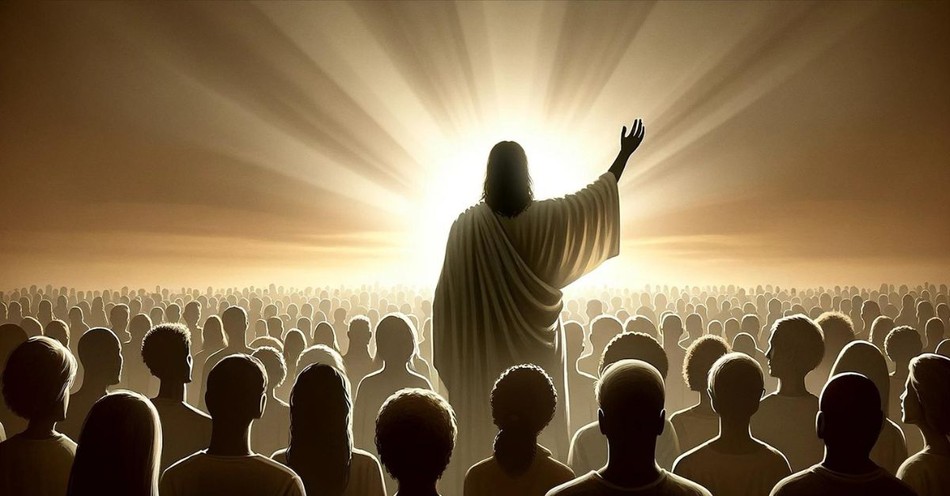When I was a child, I had a picture of Jesus. I’m not sure how I got it or who gave it to me, but I’d stare at it for long periods, trying to will my prayers his way, as if this somehow made them stronger. He wore a cloak with deep, soulful eyes that gazed heavenward, long light brown hair, and pale skin with a hint of golden undertones, just like mine.
As a White girl with a picture of a White Jesus, I didn’t think much about race back then. Jesus was a mystery for me—a brother, friend, and savior all rolled into one, except he lived in heaven. He didn’t become genuine to me until much later.
By then, I realized Jesus probably looked nothing like that picture I’d tucked into my Bible all those years ago.
The Bible doesn’t tell us much about what Jesus looked like. We can infer some things, but none of us have any idea, and this is probably a good thing. Perhaps the utter lack of physical description is a message in itself: We must avoid presumption and care nothing about external appearance, for we ourselves are skin and bones whose bodies will eventually die and decay.
Still, we are human, and many wonder what our savior might have looked like. What color were his eyes when he looked into the face of the blind man and commanded him to see? What color was his hand as he reached out and touched the sick and infirm?
Was Jesus Black? Brown? Was Jesus White?
No one knows for sure, but based on what we know about him, his ancestry, and other details, Jesus was likely not White.
Let’s dive into scripture for a look at this question.
What race was Jesus?
We know one definitive thing about Jesus: He, as a Jewish man, descended from a long line of Jewish men. The Gospel of Matthew lists his ancestry in great detail. He was descended from Abraham, father of Isaac, father of Jacob, father of Judah, all the way down to King David and then King Solomon, and further still until we get to Joseph, his earthly father (Matthew (1:1-17). Matthew tells us Joseph was the son of Jacob, son of Matthan, son of Eleazar, son of Elihud.
However, we also know Joseph was not his father—God was. Scripture tells us Jesus was born of Mary, a virgin, who was impregnated by the Holy Spirit (v. 18).
The Gospel of Luke also provides Jesus’s ancestry, only that ancestry is Mary’s, his mother’s. Luke 3:23-38 tells us Jesus was around 30 years old when he began his ministry, and he was the son of Joseph, Heli, Matthat, Levi, and Melki. We can infer this is Mary’s lineage and Joseph’s through marriage, given what Matthew’s gospel shared in identifying Joseph as the son of Jacob, not Heli.
Jesus had a long Jewish lineage on both sides of the family, and even without Joseph’s line, his mother was Jewish.
However, while being Jewish is a religion, not a race, it is also a distinct ethnicity. God urged his chosen nation, the Jews, not to marry foreigners lest they become influenced by their gods. Yet we know they still did marry people of other races and religions.
Abraham, the father of both the Hebrew-Israelite and Arab nations, was descended from Shem, son of Noah (Genesis 11:10-26). Based on where they lived in the world, his skin color would have been dark, somewhere between a reddish brown and black.
King David, a more recent ancestor of Jesus and also descended from Abraham, was described as “ruddy” with “beautiful eyes and was handsome” (1 Samuel 16:12 ESV). The Hebrew word in the original text, admônî, translates to reddish-colored skin or skin glowing with health.
David is descended from Boaz, who married Ruth, a Moabite woman (Ruth 1:4) who converted to Judaism. Many Moabites were thought to have had darker skin. So, while Jesus was a Jew, both in ethnicity and religion, we don’t know what that means for his skin tone. He was descended from people with darker skin who likely married foreign women, many of whom had dark skin.
Song of Songs thought to have been written by King Solomon, another ancestor of Jesus, speaks of his wife with lovely black skin (Song of Songs 1:5), so it is possible and perhaps likely that Jesus could also have descended from the woman in this song. Given all this, it is highly doubtful Jesus had pale or Caucasian-looking skin.
Also, note that he would have looked like the other people in his day. He wasn’t “special” in appearance but was considered rather ordinary-looking. When Judas, his betrayer, encountered him in the Garden of Gethsemane, the plan was for Judas to kiss Jesus so the soldiers would know who to arrest (Mark 14:44). Presumably, he would not have stood out from the rest of his friends. He would have looked like any other Jewish man of his day.
Was Jesus Black?
Some scholars believe Jesus was Black, but again, there is no evidence of this, either. However, because of the number of dark-skinned people in his lineage and because Jesus lived in Africa (Egypt), several people believe Jesus was dark-skinned and looked more than a northern African man would have looked then—that is, Black.
Some also cite Revelation 1:14-15, which depicts a transfigured Jesus: “The hairs of his head were white, like white wool, like snow. His eyes were like a flame of fire, his feet were like burnished bronze, refined in a furnace, and his voice was like the roar of many waters.”
The original Greek for wool here is erion, which means thread. A description of Jesus with “woolly” hair would not be consistent with a White man’s typical hair texture and more likely to be someone either Black or Middle Eastern.
Why do people depict Jesus as White?
This begs the question: If Jesus was very likely not White, why did so many artists depict him this way?
One theory is about how Christianity spread with the Roman Empire. A long-haired, White-looking Jesus began to emerge in the fourth century, and Jesus was painted to look much like the other images of deities in that day—a lot like Roman or Greek gods. As Christianity spread across Europe, artists increasingly painted a Christ that reflected the ideal physical beauty of that day. His mother, Mary, often sported blond hair and blue or light eyes. As the years passed and Europeans colonized far-off places, the colonizers brought this “White Jesus” with them and taught new converts how to create art in this manner.
An Asian Jesus?
Of course, art is subjective, and artists have always enjoyed creative license. Also, artists often portray Jesus as he would have looked like in their culture. Asian artists often depict an Asian-looking Jesus. Latino artists depict a Latino-looking Jesus. African artists depict Jesus as an African. The point is not about capturing a genuine likeness but showcasing our Lord and Savior in a way that uplifts and glorifies him.
Does Jesus' race matter?
In truth, what Jesus looked like matters none. Isaiah 53:2 describes an ordinary-looking Messiah. We know he was born in a manger in a stable in Bethlehem to humble parents from Nazareth, a place of little regard. Indeed, when Philip was about to introduce his friend Nathanael to Jesus, the Bible tells us Nathanael said to him, “‘Can anything good come out of Nazareth?’ Philip said to him, ‘Come and see’” (John 1:46 ESV).
How Jesus looked doesn’t matter. He looked nothing like the mighty, triumphant savior the Jews had hoped would deliver them from oppression. Instead, God sent his son into the world as a tiny baby, the lowest of low. His arrival, ministry, and ultimate crucifixion and resurrection set the world on end, forever changing us. That’s what matters.
Photo Credit: Featured image created using AI technology on ChatGPT



_639003522088907085.jpg)
